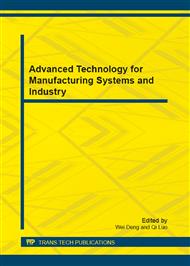p.409
p.414
p.418
p.422
p.428
p.434
p.439
p.443
p.448
Polishing Optical Glass by Mechanochemical Machining
Abstract:
This study examined the surface defects and surface roughness of optical glass polished by mechanochemical machining. BK7 optical glass material was polished using cerium oxide (CeO2) solutions of different concentrations and temperatures. During machining, the optical glass specimen was placed between the ceramic working ring and the polishing pad. The effects of slurry concentration and temperature, polishing time, rotational speed and axial load on the surface roughness were examined. Significant improvement in surface roughness could be attained by polishing with CeO2 slurry of 95。°C. Both SEM and AFM images of BK7 polished under conditions: slurry concentration, 15%; slurry temperature, 95。C; rotational speed, 40 rpm; axial loading, 6 kg; and polishing time, 8 min show that the optical glass specimen surface had high transmittancy and became smooth with all scratches removed. The best mechanical properties in terms of Young’s modulus of elasticity and hardness were obtained by polishing with CeO2 slurry of 60。C. Although better surface roughness can be attained with further increase in slurry temperature, the enhanced reaction under high slurry temperature undermined the mechanical properties of the glass specimen.
Info:
Periodical:
Pages:
428-433
Citation:
Online since:
November 2012
Authors:
Keywords:
Price:
Сopyright:
© 2012 Trans Tech Publications Ltd. All Rights Reserved
Share:
Citation:


